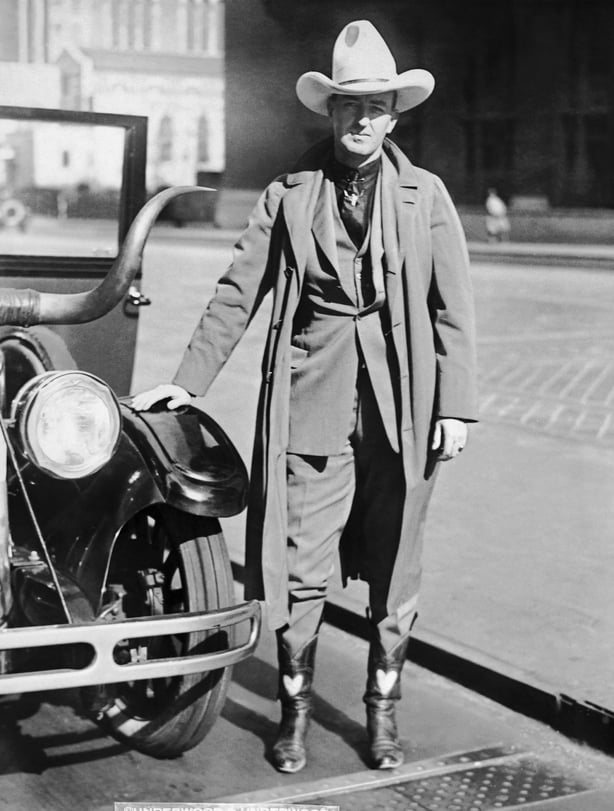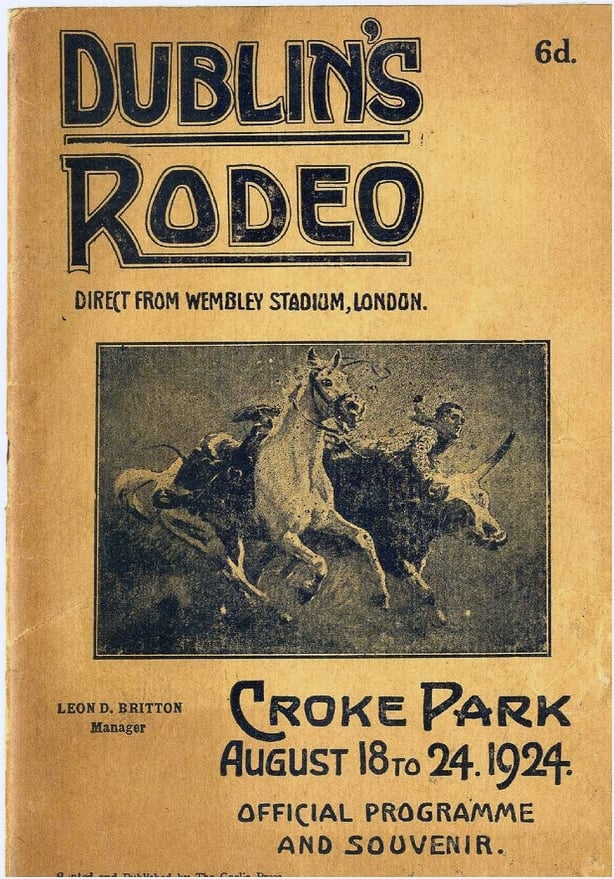Analysis: The stadium hosted Tex Austin's travelling rodeo featuring bronc riding, calf roping and other Wild West entertainments
This article is now available above as a Brainstorm podcast. You can subscribe to the Brainstorm podcast through Apple Podcasts, Stitcher, Spotify or wherever you get your podcasts.
By Conor Heffernan, Ulster University
This year marks the 100th anniversary of Tex Austin's 1924 rodeo in Ireland, a unique and somewhat unconventional event which saw cowboys and cowgirls perform to packed audiences at Croke Park. Following in the wake of the 1924 Tailteann Games, Austin’s rodeo brought the dynamism of the American West to Irish soil. The event contrasted with the traditional festivities of the Games, introducing Ireland to the exhilarating world of bronc riding, calf roping, and circus entertainment.
Significantly, the inclusion of Irish-American riders created a cultural connection that resonated deeply with the Irish audience. This wasn’t just a cultural curio. Thanks to the Irish roots of several rodeo riders, it was a celebration of Irish diaspora, tinged with a cowboy ethic. A century later, this anniversary provides an opportunity to reflect on the rodeo’s role in the cultural exchange between Ireland and America, and its impact on Ireland's burgeoning cultural identity.
What excitement down at Croke Park where the Rodeo was staged,
It came to us in Ireland as a boon,
For all the champion riders in the world were engaged,
We had thrills and spills throughout the afternoon …
P.C., The Kerryman, September 6th, 1924.
Meet Tex Austin, the rodeo Innovator

The 1924 rodeo was set against a backdrop of Ireland’s new political independence and cultural reinvention, a point evidenced by the Tailteann Games, which were known colloquially as an Irish race Olympics. It was originally planned to be part of the Tailteann, a plan made odder by the fact that 'foreign' games like football were banned from the games, but bronco riding was apparently fine. That the rodeo was even considered for the Tailteann was undoubtedly down to the charisma of its owner.
Born Clarence Van Nostrand in Missouri, Tex Austin emerged from humble beginnings to become one of the most celebrated rodeo promoters of his time. His journey to fame began in 1917 when he brought indoor rodeo performances to cities across the United States. Prior to this innovation, rodeos were largely held in open, peripheral spaces, limiting their accessibility and audience reach. This novel approach brought the rodeo from its traditional outdoor rural settings into the heart of American cities.
Austin’s success was rooted in his ability to transform the rodeo into a form of urban entertainment. His shows were characterized by their authenticity and danger, differentiating them from the more theatrical and embellished 'Buffalo Bill' shows of the late 19th century.

This commitment to presenting a ‘real’ and raw representation of Western cowboy culture was a key factor in the popularity of Austin's events. It also brought the rodeo promoter to the attention of animal rights groups. His shows often included events that many considered to be animal cruelty, leading to protests and public debates, particularly during New York shows in the early 1920s. Despite this controversy, Austin's rodeos drew large crowds, captivated by the thrill and spectacle of his events.
Austin's reputation led to his participation in global tours as evidenced by his rodeos inclusion in the 1924 British Empire Exhibition in London, as well as Ireland. When Austin brought his rodeo to Ireland, it was not merely an exhibition of American cowboy skills but a cultural phenomenon deeply intertwined with his own journey and vision.
The Irish-American rodeo hits Croker
Austin’s rodeo was hosted at Croke Park for several days and was enhanced by the inclusion of Irish-American riders, who served as cultural links between the American West and Irish heritage. Among these were Vera McGinnis, Tony Kernan and Rabe Roberts, each bringing a unique blend of rodeo skill and Irish ancestry.
From British Pathé, the rodeo arrives in Dublin
McGinnis stood out not only for her exceptional riding abilities, but also as one of the few women in the rodeo scene. Her Irish roots (her mother was from Killeshandra, Co. Cavan) made her an icon of shared heritage, especially for the Irish audience. Along with her peers, she found the reception in Ireland to be particularly warm and welcoming, a stark contrast to other countries. This enthusiastic welcome was indicative of the Irish public’s admiration for their Irish-American heritage. McGinnis’ biography later noted overflowing champagne glasses and endless fun during her Irish sojourn.
Kernan and Roberts also garnered attention and acclaim for their skills and Irish lineage. Their participation transcended the mere performance aspect of the rodeo, elevating them to symbols of a shared Irish-American legacy. The Irish media and public were keen on celebrating their Irish roots, thereby deepening the cultural significance of their performances.
By highlighting his Irish-American riders, as well as engaging in fundraising activities for Irish charities, Austin tapped into the cultural consciousness of the Irish public. Their presence not only generated greater interest, but also added emotional depth to the event. Representing both the American West and their Irish descent, these riders’ involvement made the rodeo a poignant symbol of shared Irish and American lifestyles.
From British Pathé, highlights of the action from the Croke Park rodeo in 1924
Irish cowboys and cowgirls
The impact of Austin’s rodeo extended far beyond the event itself, marking the beginning of a deeper Irish engagement with American popular culture, specifically the cowboy and frontier imagery. The rodeo’s influence was evident in the rise of cowboy-themed literature, films, and public entertainment (including a tour by ‘singing cowboy’ Gene Autry in 1939) in Ireland. It resonated particularly with Irish men, offering narratives of adventure, moral righteousness, and rugged individualism.
In the years following the rodeo, cowboy culture became increasingly prominent in Irish society. The cowboy was idealised in various forms of media from pulp fiction to cinema. These stories featured themes of self-reliance, moral clarity, and mastery over the natural world, aligning with the values and aspirations of many Irishmen. The cowboy, often portrayed as a hero in good-versus-evil narratives, provided a template for masculine identity.
The enduring popularity of cowboy culture in Ireland highlights the complexities of Irish-American cultural exchange during the interwar period
The cowboy's appeal in Ireland was multifaceted. For some, it offered a form of escapism from the realities of everyday life. For others, the cowboy represented a model of rugged masculinity to be emulated. The themes of mastery over nature and animals, prevalent in cowboy narratives, resonated with the rural Irish masculine identity. The rodeo and the subsequent influx of cowboy culture provided a new visual medium for Irish men and boys to engage with these ideals.
The enduring popularity of cowboy culture in Ireland highlights the complexities of Irish-American cultural exchange during the interwar period. It underscores how international cultural influences can shape national identities, particularly in a country navigating its newfound sovereignty. The legacy of Austin's rodeo and the enduring fascination with cowboy culture in Ireland reflected the dynamic and multifaceted nature of cultural interactions in the early 20th century.
Follow the RTÉ Brainstorm WhatsApp channel for all our stories and updates
Dr Conor Heffernan is Lecturer in the Sociology of Sport at Ulster University. He also runs the history of fitness website Physical Culture Study and is a former Irish Research Council awardee. His latest book, Indian Club Swinging and the Birth of Global Fitness, is published by Bloomsbury.
The views expressed here are those of the author and do not represent or reflect the views of RTÉ
